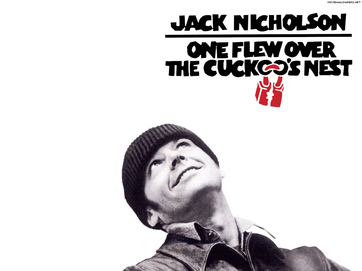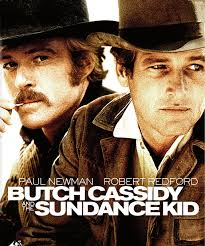Milos Forman created a masterpiece when he filmed OneFlew
over the Cuckoo’s Nest in 1975, based on the novel by Ken Kesey. When
I watched this film for the first time, I did not see actors portraying the
characters but the characters as real people that I felt for. The premise of
the film, is determining who is “normal,” or sane (both are relative terms),
and who is not in the mental institution that the majority of the film takes place in.
The opening or establishing shot of the film is absolutely beautiful. It is
a shot of the sun rising behind a mountain; the only artificial or man-made
thing in the entire shot is a pair of headlights that belong to the car bringing
Jack Nicholson’s character, McMurphy, to the mental institution. If you did not
hear the music in the establishing shot, you would think that it was very
peaceful and that there was nothing wrong. There are some birds calling and the
sun rising, but there is also some slightly ominous or at the very least
unsettling music that gradually becomes noticeable. The score that Jack Nitzsche
wrote for this scene feels a bit foreboding, it is just unsettling enough to
make the audience think that not all is as it
seems, a common theme throughout the movie. At the ending of the film,
Forman essentially recreates this shot, bookending the movie with shots of
peaceful paradise. This closing shot seems to tell the audience that
everything is as it should be, whether they truly are or not remains
unknown but the audience is allowed to assume that things are as they
should be. That is the power that two simple and similar shots can have in
one movie.
As for the acting, it is absolutely amazing. I think that it is even more
amazing now that I have an even better understanding of what all is required of
the actors in a cinema production. The movie may be filmed out of continuity,
not in chronological order, there is not a lot of rehearsal time, the other
actors in the scene may not be present, and they have to make it their marks.
The actors have to do all of this and at the same timelook natural while doing
it and behave like there is no camera there. The actors in One
Flew over the Cuckoo’s Nest achieve all of this and
I at the very least felt an emotional attachment to the characters very
early on in the film. At first, McMurphy is the only character that seems
truly human and because of that he feels unpredictable, like you literally
have no idea what he is capable of but you know that whatever he sets his
mind to he can do it. The other characters,inmates of the mental
hospital, are all very stoic and passive compared to McMurphy at the very
least. Granted these characters are all on meds so that is a
contributing factor, but they are almost not human. Throughout the
filmthough they regain their humanity and they become fully human
again through McMurphy’s help.
When Billy (Brad Dourif) talks about his suicide attempt you feel his
pain, the acting is that good. When McMurphy throws the party, you can feel the
happiness that the characters feel, same as when they all go fishing. It is a
new experience for them to be happy; it is like they are experiencing the world
for the first time again. In the end (spoiler alert) when Billy commits suicide,
the despair and humiliation that he feels is like a physical thing in the room
with you as you watch it and I just wanted to give him a hug and tell him it
would all be ok if he would just hold on a little bit longer. Also when (spoiler
alert) the Chief kills McMurphy you can really tell that he thinks he is setting
McMurphy free because the Chief knows that McMurphy would not want to continue
on in the state of mind that he is in at that point, because the mental hospital
literally made him crazy by messing with his brain.
Overall, this is a phenomenal movie and anyone who has not seen it should
go and see it. That acting is incredible and so are the cinematography,
directing, and producing. It is truly no wonder that the film won five Oscars,
along with thirty other wins and twelve other
nominations.
Sources Cited
One
Flew over the Cuckoo’s Nest.
Dir. Milos Forman. Perf. Jack
Nicholson, Louise Fletcher, and Michael Berryman.
Fantasy Films, 1975.
DVD.
“One Flew over the
Cuckoo’s Nest.” IMDB.
IMDB.com, Inc. 1990-2013. Web. 24, Oct.
2013.
Prince, Stephen
R. Movies and Meaning: an Introduction to Film.
6th ed. Boston, MA: Pearson
Education, Inc., 2013. Print.
https://www.google.com/search?hl=en&site=imghp&tbm=
isch&source=hp&biw=1366&bih=641&q
=one+flew+over+the+cuckoo%27s+nest&oq=one+flew+o&gs_l=img.3.0.0l10.1613.3567.
0.4644.10.7.0.3.3.0.179.506.6j1.7.0....0...1ac.1.29.img..
1.9.353.SeHbbwwsG4Y#facrc=_&imgdii=_&imgrc=YuSLmqnn
476iJM%3A%3BXsGfOYigMRh5QM%3Bhttp%253A%252F%
252Fmediasnobs.com%252Fwp-content%252Fuploads%252
F2013%252F08%252FOne-Flew-Over-The-Cuckoos-Nest-
Movie-Poster.jpg%3Bhttp%253A%252F%252Fmediasnobs.com
%252Fmovie-review%252Fone-flew-cuckoos-nest%252F%3B1024%3B768
over the Cuckoo’s Nest in 1975, based on the novel by Ken Kesey. When
I watched this film for the first time, I did not see actors portraying the
characters but the characters as real people that I felt for. The premise of
the film, is determining who is “normal,” or sane (both are relative terms),
and who is not in the mental institution that the majority of the film takes place in.
The opening or establishing shot of the film is absolutely beautiful. It is
a shot of the sun rising behind a mountain; the only artificial or man-made
thing in the entire shot is a pair of headlights that belong to the car bringing
Jack Nicholson’s character, McMurphy, to the mental institution. If you did not
hear the music in the establishing shot, you would think that it was very
peaceful and that there was nothing wrong. There are some birds calling and the
sun rising, but there is also some slightly ominous or at the very least
unsettling music that gradually becomes noticeable. The score that Jack Nitzsche
wrote for this scene feels a bit foreboding, it is just unsettling enough to
make the audience think that not all is as it
seems, a common theme throughout the movie. At the ending of the film,
Forman essentially recreates this shot, bookending the movie with shots of
peaceful paradise. This closing shot seems to tell the audience that
everything is as it should be, whether they truly are or not remains
unknown but the audience is allowed to assume that things are as they
should be. That is the power that two simple and similar shots can have in
one movie.
As for the acting, it is absolutely amazing. I think that it is even more
amazing now that I have an even better understanding of what all is required of
the actors in a cinema production. The movie may be filmed out of continuity,
not in chronological order, there is not a lot of rehearsal time, the other
actors in the scene may not be present, and they have to make it their marks.
The actors have to do all of this and at the same timelook natural while doing
it and behave like there is no camera there. The actors in One
Flew over the Cuckoo’s Nest achieve all of this and
I at the very least felt an emotional attachment to the characters very
early on in the film. At first, McMurphy is the only character that seems
truly human and because of that he feels unpredictable, like you literally
have no idea what he is capable of but you know that whatever he sets his
mind to he can do it. The other characters,inmates of the mental
hospital, are all very stoic and passive compared to McMurphy at the very
least. Granted these characters are all on meds so that is a
contributing factor, but they are almost not human. Throughout the
filmthough they regain their humanity and they become fully human
again through McMurphy’s help.
When Billy (Brad Dourif) talks about his suicide attempt you feel his
pain, the acting is that good. When McMurphy throws the party, you can feel the
happiness that the characters feel, same as when they all go fishing. It is a
new experience for them to be happy; it is like they are experiencing the world
for the first time again. In the end (spoiler alert) when Billy commits suicide,
the despair and humiliation that he feels is like a physical thing in the room
with you as you watch it and I just wanted to give him a hug and tell him it
would all be ok if he would just hold on a little bit longer. Also when (spoiler
alert) the Chief kills McMurphy you can really tell that he thinks he is setting
McMurphy free because the Chief knows that McMurphy would not want to continue
on in the state of mind that he is in at that point, because the mental hospital
literally made him crazy by messing with his brain.
Overall, this is a phenomenal movie and anyone who has not seen it should
go and see it. That acting is incredible and so are the cinematography,
directing, and producing. It is truly no wonder that the film won five Oscars,
along with thirty other wins and twelve other
nominations.
Sources Cited
One
Flew over the Cuckoo’s Nest.
Dir. Milos Forman. Perf. Jack
Nicholson, Louise Fletcher, and Michael Berryman.
Fantasy Films, 1975.
DVD.
“One Flew over the
Cuckoo’s Nest.” IMDB.
IMDB.com, Inc. 1990-2013. Web. 24, Oct.
2013.
Prince, Stephen
R. Movies and Meaning: an Introduction to Film.
6th ed. Boston, MA: Pearson
Education, Inc., 2013. Print.
https://www.google.com/search?hl=en&site=imghp&tbm=
isch&source=hp&biw=1366&bih=641&q
=one+flew+over+the+cuckoo%27s+nest&oq=one+flew+o&gs_l=img.3.0.0l10.1613.3567.
0.4644.10.7.0.3.3.0.179.506.6j1.7.0....0...1ac.1.29.img..
1.9.353.SeHbbwwsG4Y#facrc=_&imgdii=_&imgrc=YuSLmqnn
476iJM%3A%3BXsGfOYigMRh5QM%3Bhttp%253A%252F%
252Fmediasnobs.com%252Fwp-content%252Fuploads%252
F2013%252F08%252FOne-Flew-Over-The-Cuckoos-Nest-
Movie-Poster.jpg%3Bhttp%253A%252F%252Fmediasnobs.com
%252Fmovie-review%252Fone-flew-cuckoos-nest%252F%3B1024%3B768


 RSS Feed
RSS Feed